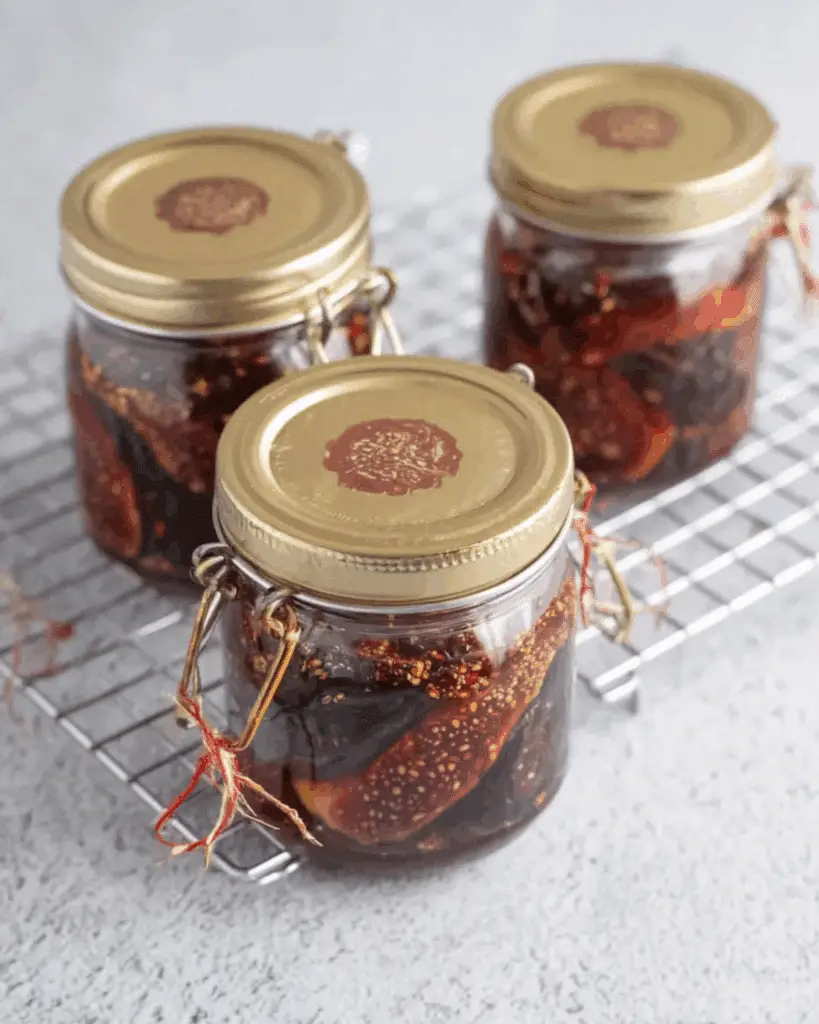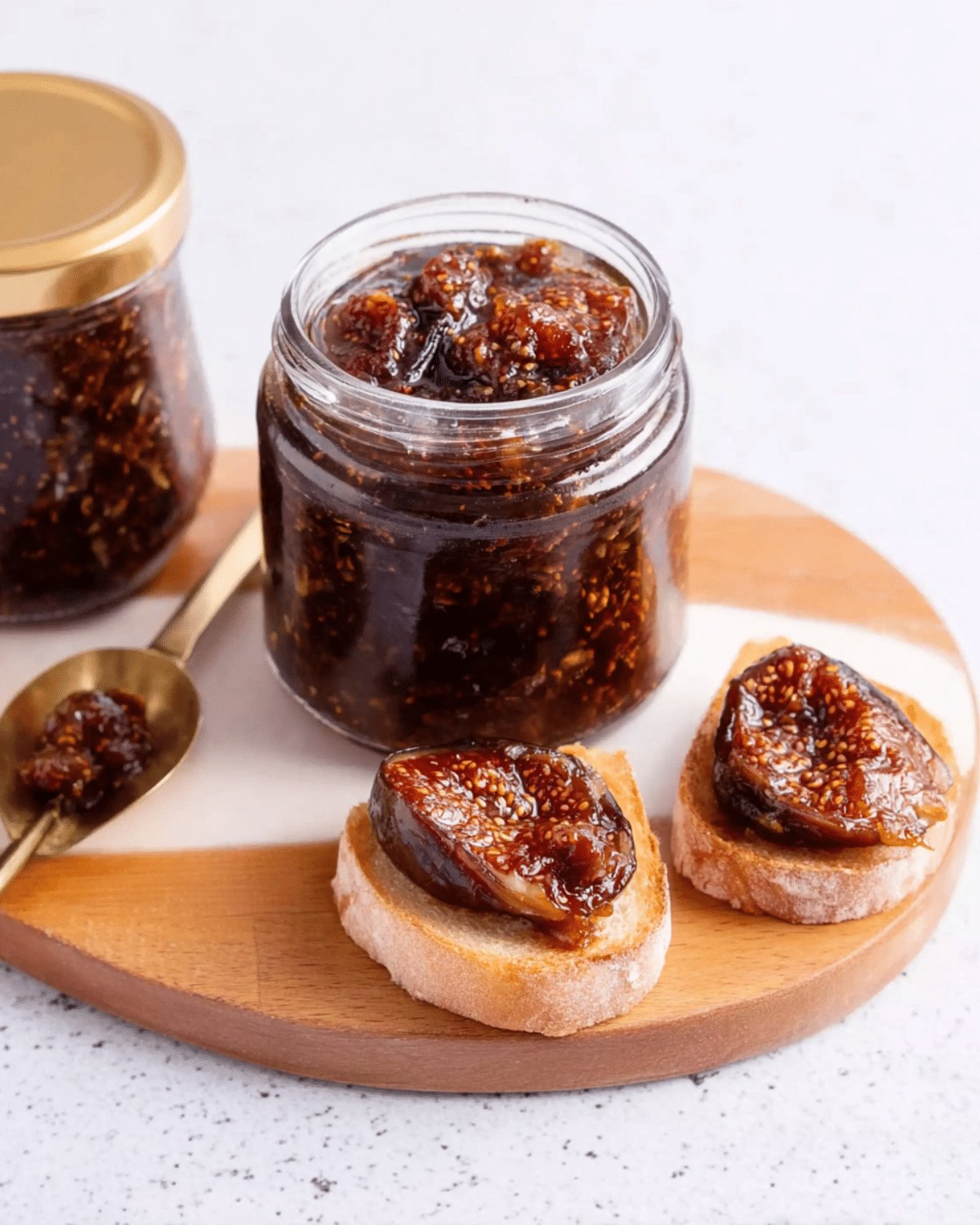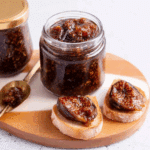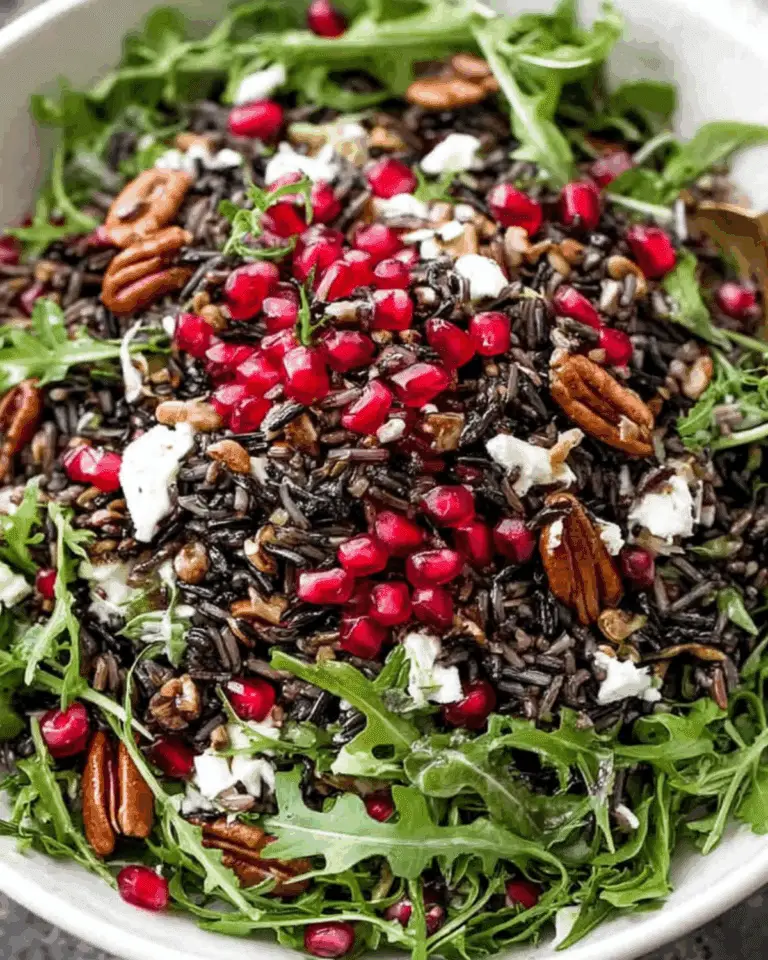Preserved figs are one of the best-kept secrets of Southern kitchens. While fresh figs have a notoriously short season, learning how to preserve them allows you to enjoy their rich, honey-like sweetness all year long. Whether you’re new to canning or just looking for a tried-and-true method, this guide walks you through everything you need to know. From ingredients and preparation tips to creative uses and storage methods, this article covers it all.
If you’re looking for creative pantry ideas, don’t miss our classic homemade cranberry sauce which pairs beautifully with preserves.
JUMP TO
Table of Contents
Why Preserved Figs Are a Pantry Essential
The Seasonal Nature of Fresh Figs
Fresh figs are elusive. They appear for just a few short weeks in early summer and again in late fall. Because they spoil quickly—often within days of harvest—it’s easy to lose a batch before enjoying it. That’s exactly why preservation matters. Canning figs not only locks in their lush texture and natural sugars but also makes them shelf-stable for months.
Figs don’t travel well either. Unlike apples or citrus, figs bruise easily and aren’t suited for long-distance shipping. Preserving figs close to the source—whether your backyard tree or a local farmer’s market—ensures you capture their peak flavor.
Health Benefits of Figs in Your Diet
Beyond their sweet taste and culinary versatility, figs are a nutritional powerhouse. They’re naturally rich in:
| Nutrient | Benefits |
|---|---|
| Dietary fiber | Supports digestion, controls appetite |
| Potassium | Helps regulate blood pressure |
| Calcium | Supports bone health |
| Antioxidants | Fights cell damage |
Preserved figs retain much of their original fiber and mineral content. Unlike commercially made jams that may include additives, homemade preserves using whole figs and lemon slices maintain a closer-to-natural profile.
Discover great ideas like our healthy pumpkin oat cookies recipe if you’re looking to build a pantry with both flavor and nutrition.
Preserving as a Waste-Free, Flavor-Rich Solution
If you’ve ever stood in front of an overflowing fruit basket wondering what to do with soft, overripe produce, you’re not alone. Preserving figs offers a solution that reduces food waste and enhances your culinary routine. Unlike freezing, which can change the fig’s texture, or drying, which concentrates sugars too much, preserving them in syrup retains their tender bite and makes them incredibly versatile.
Check out canning fresh peaches for another smart seasonal preservation project that brings summer to your pantry in every jar.
How to Make Traditional Southern Preserved Figs
Southern fig preserves are simple, timeless, and remarkably forgiving. All you need are fresh figs, sugar, and lemon slices—no added pectin, no fancy tools. This section breaks down the exact method for turning ripe figs into golden, syrupy preserves perfect for toast, baking, or cheese boards.
Simple Ingredients You’ll Need
You only need three ingredients for this authentic fig preserves recipe:
| Ingredient | Amount | Notes |
|---|---|---|
| Fresh figs | 6 pounds (about 18 cups) | Peeled or unpeeled, washed & stemmed |
| Sugar | 2 to 6 pounds, to taste | Start with 2 pounds and adjust |
| Lemon | 2 whole lemons, thinly sliced | Seeds removed, for brightness |
The balance of sugar and lemon gives preserved figs a beautiful sweet-tart flavor that deepens during cooking. Figs naturally contain enough pectin, so there’s no need for store-bought additives.
Looking for inspiration? Try our delicious lemon lavender loaf recipe to complement these preserves for a sweet breakfast or afternoon snack.
Overnight Sugar-Maceration Method
This step is essential and requires a little planning. Here’s how to prepare your figs:
- In a large heavy-bottom pot or Dutch oven, place your cleaned figs.
- Pour 2 pounds of sugar evenly over the fruit.
- Cover the pot and allow the mixture to sit overnight at room temperature.
Why this matters: Letting the figs rest overnight draws out their natural juices. It also softens the skins and ensures the sugar begins dissolving gently, leading to a smoother syrup.
If your fig variety is extra sweet (like Black Mission), feel free to reduce the sugar slightly. On the flip side, if your figs are less ripe or more tart, you may want to bump it up.
Don’t miss our nectarine crumble bars recipe for another excellent way to work with fresh fruit.
Step-by-Step Fig Preserve Cooking Guide
After the overnight maceration, the real transformation begins. Follow these steps:
- Place the pot over medium heat and stir constantly for about 15 minutes until all the sugar dissolves.
- Reduce heat to low. Add thinly sliced lemons to the mixture.
- Cover and cook the figs slowly for 1½ to 2 hours, stirring occasionally. You’ll notice the figs becoming translucent and the syrup thickening.
Optional but helpful: Attach a candy thermometer and simmer until the mixture reaches 200°F, about 45 minutes more. This ensures the right consistency without overcooking.
You’ll know it’s done when the syrup thickens enough to coat the back of a spoon, and the figs look rich and jammy.
Check out classic Italian bruschetta recipe as a creative use for fig preserves in savory dishes.
Tips for Adjusting Sugar Levels and Lemon Balance
Taste as you go. After dissolving the sugar but before the final simmer, give the mixture a spoon test:
- If it’s overly sweet, a splash of lemon juice (beyond the slices) can help balance it.
- If too tart, consider adding a touch more sugar in small amounts.
Pro tip: Use Meyer lemons for a sweeter citrus profile, or layer in some orange zest for complexity.
Southern cooks often play with flavor by adding a cinnamon stick or a few cloves to the pot. These additions are optional but delicious.
Don’t miss our pumpkin spice coffee cake recipe to serve with a spoonful of fig preserves on the side.
Canning and Storing Preserved Figs Safely
Homemade preserved figs aren’t just flavorful—they’re shelf-stable when stored correctly. Proper storage means enjoying figs for months without spoilage or texture loss. Let’s break down the best ways to can and preserve your bounty safely.
How to Sterilize Jars and Prep for Canning
Sterilization is essential to avoid bacteria growth and ensure a tight seal. Here’s a quick refresher:
- Wash jars, lids, and rings in hot, soapy water.
- Place jars in a boiling water bath for 10 minutes.
- Keep them hot until ready to fill.
As you finish cooking the figs, ladle the hot preserves into hot jars, leaving about ¼-inch headspace. Wipe the rims, apply the lids and bands, and prepare for the water bath.
Looking for another holiday-friendly preserve? Don’t miss our homemade pumpkin jam recipe for your autumn spread.
Water Bath Canning vs. Refrigerator vs. Freezing
| Storage Method | Shelf Life | Notes |
|---|---|---|
| Water bath | 12 months | Best for pantry storage |
| Refrigerator | 3 weeks | Ideal for quick use or unsealed jars |
| Freezer | 6 months | Leave space for expansion in containers |
If you’re canning for long-term storage, place filled jars into boiling water (1″ above lids) and boil for 10 minutes (15 at higher altitudes). Remove and let cool completely.
Unsealed jars should be refrigerated and used within a few weeks—or freeze them for later.
Check out our easy pumpkin bread with crumb topping for a perfect pairing with fig preserves at breakfast.
Shelf Life and Ideal Storage Conditions
Once sealed and cooled, jars of preserved figs should be stored in a cool, dark place such as a pantry or cellar. Always:
- Label with the date
- Check seals after 24 hours
- Discard if mold or fermentation signs appear
Preserved figs typically last up to one year unopened. Once opened, store in the refrigerator and use within 3 weeks.
Creative Ways to Use Preserved Figs
You’ve made these gorgeous preserves—now how should you serve them? The beauty of fig preserves is how many ways they elevate both sweet and savory dishes.
Spread on Toast, Biscuits, and Muffins
Start your morning strong with a dollop of fig preserves on fresh bread or warm biscuits. Their natural sweetness works beautifully on whole wheat, sourdough, or cornbread muffins.
Want more cozy ideas? Try our crustless pumpkin pie recipe with a side of fig preserves for a fall-forward brunch treat.
Pairing with Cheese and Charcuterie
Fig preserves are a cheese board staple. The sweet-tart flavors balance sharp cheeses like:
- Aged cheddar
- Goat cheese
- Brie or Camembert
- Blue cheese
Add crackers, toasted nuts, and sliced prosciutto for a no-fuss appetizer.
Adding Richness to Glazes and Desserts
Preserved figs also work in savory sauces and glazes for roasted meats. You can whisk them into balsamic reductions or stir into cake batters for an earthy sweetness.
For dessert lovers, spoon fig preserves over vanilla ice cream or swirl into cheesecake for depth and richness.

Frequently Asked Questions About Preserved Figs
What’s the best type of fig for preserving?
Any variety works, but Celeste, Mission, and Brown Turkey are most popular. They hold their shape well and offer rich flavor.
Do preserved figs need to be refrigerated?
Only once opened. Sealed jars stored in a pantry don’t need refrigeration.
How long can preserved figs last unopened?
Properly canned jars can last 12 months if stored in a cool, dark place. Once opened, consume within 3 weeks.
Can you make preserved figs without sugar?
Sugar is essential for flavor and preservation. You can reduce the amount, but skipping it entirely isn’t recommended unless using alternative preservation methods like freezing.
Conclusion: Make the Most of Fig Season with Preserves
Preserving figs captures the fleeting magic of fig season in every jar. Whether you’re a home cook with a tree full of fruit or a market shopper hunting the ripest basket, learning how to make preserved figs is a satisfying and rewarding process. With a few ingredients and a bit of time, you’ll have a spread that enhances everything from toast to charcuterie to desserts.
Don’t miss our bourbon peach upside-down cake recipe for a summer dessert that complements the sweet complexity of fig preserves.
PrintPreserved Figs
Learn how to make Southern-style preserved figs using just three ingredients. This easy method involves overnight maceration and slow cooking for a flavorful, long-lasting pantry staple.
- Prep Time: 12 hours (includes overnight rest)
- Cook Time: 2 hours 45 minutes
- Total Time: 14 hours 45 minutes
- Yield: Approximately 6 to 8 pint-sized jars
- Category: Preserves
- Method: Canning
- Cuisine: Southern
- Diet: Vegetarian
Ingredients
- 6 pounds fresh figs, peeled or unpeeled (approximately 18 cups)
- 2 to 6 pounds granulated sugar, to taste
- 2 lemons, very thinly sliced, seeds removed
Instructions
- Wash, dry, and stem the figs.
- Place figs in a large Dutch oven or heavy pot and pour 2 pounds of sugar over them.
- Cover and let sit overnight to macerate.
- The next day, taste and add more sugar if needed.
- Place the pot over medium heat and stir constantly until sugar dissolves, about 15 minutes.
- Reduce heat to low, add lemon slices, and cover the pot.
- Cook, stirring occasionally, for 1.5 to 2 hours until figs are translucent and syrup thickens.
- Continue simmering until the mixture reaches 200°F, about 45 more minutes.
- Sterilize jars and lids in boiling water for 10 minutes.
- Pour hot preserves into hot jars, leaving 1/4-inch headspace. Wipe rims and seal with lids and rings.
- Process jars in a boiling water bath for 10 minutes (15 minutes at high altitude).
- Let jars cool completely and check for seals before storing in a cool, dark place.
Notes
- Use Meyer lemons for a sweeter citrus note.
- Optional additions: cinnamon stick or cloves for extra flavor.
- Unsealed jars must be refrigerated or frozen.
- Properly canned jars can last up to one year.
Nutrition
- Serving Size: 2 tablespoons
- Calories: 359
- Sugar: 89g
- Sodium: 2mg
- Fat: 0g
- Saturated Fat: 0g
- Unsaturated Fat: 0g
- Trans Fat: 0g
- Carbohydrates: 93g
- Fiber: 3g
- Protein: 1g
- Cholesterol: 0mg








